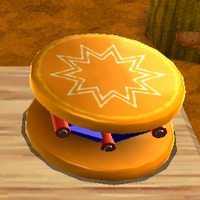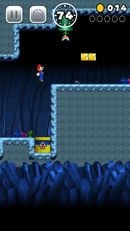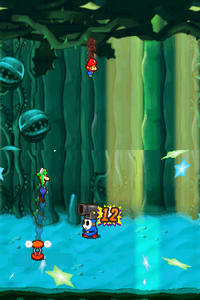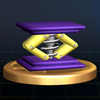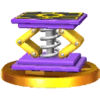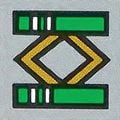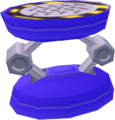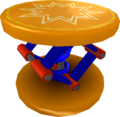Trampoline
| It has been suggested that this page be split into the following: Spring-Up, Trampoline, Trampoline (Super Mario RPG: Legend of the Seven Stars), Trampoline Floor. (discuss) |
- This article is about the items capable of bouncing the player. For other uses, see Trampoline (disambiguation).
- Not to be confused with jack.
- “I found a springboard for you! Ground-pound it to bounce high!”
- —Luma, Super Mario Galaxy 2
Trampolines, also known as springs or Springboards[1][2][3], are items that appear in the Donkey Kong series and the Mario franchise.
History
Donkey Kong series
Donkey Kong Jr.
In Donkey Kong Jr., a Jump Board[4], or spring board[5], is prominently featured in the game's second level. Junior can use it to jump over a gap but can also use it as a shortcut to reach the hovering platform above it.
Donkey Kong (Game Boy)
In Donkey Kong for the Game Boy, Jump Stands[6] appear. They are found throughout levels, and occasionally use varying designs. If Mario jumps on one, he can jump higher than usual. In addition, some Jump Stands can be placed through the use of square icons. When Mario jumps at a Jump Stand item, the game freezes and the player has to place the Jump Stand to any free point in the level. The Jump Stand is timed and disappears after the time has passed. This timer indicated with a music that starts playing as soon as the road is placed and gets faster gradually. The timer can be reset to 0 if Mario places another Jump Stand within the first Jump Stand's time limit, or any other placeable objects such as Roads, Ladders, and blocks. After disappearing, the Jump Stand can then be reactivated.
Super Mario series
Super Mario Bros. / Super Mario Bros.: The Lost Levels
Jumping boards[7] (also referred to as Jumpers[8], Springs[9], or Spring Blocks[10]) first appear in the Super Mario series in Super Mario Bros. Upon pressing the jump button at the right time, Mario will jump with increased height.
In Super Mario Bros.: The Lost Levels, a green variety known as the Super Spring is introduced, which further increases Mario's jump height with a well-timed press of the jump button.
In Super Mario Bros. Deluxe, a smaller variant known as the Trampoline Floor[11] appears in the VS Game and You VS. Boo modes.
Super Mario World
Jumping Boards[12] (also referred to as Trampolines[13]) appear in Super Mario World. This game marks the first time the player is able to carry one, an ability which would later be carried on to future games, including the New Super Mario Bros. series.
Super Mario Sunshine
In Super Mario Sunshine, springboards appear in Noki Bay. When water touches them, they shrink and Mario is able to carry them around, allowing him to reach various high places.
Super Mario Advance 4: Super Mario Bros. 3
Springboards appear in Super Mario Advance 4: Super Mario Bros. 3 in two World-e levels: Ice Dungeon and Vexing Doors. They use the same sprite as in Super Mario World and can be carried in the same way.
New Super Mario Bros. series
Trampolines return in New Super Mario Bros., New Super Mario Bros. Wii, New Super Mario Bros. 2 and New Super Mario Bros. U, having the same function as they did in previous games.
Super Mario Galaxy
In Super Mario Galaxy, large, round, orange springboards with a Ground Pound symbol appear, which can bounce Mario extra high if he Ground Pounds on them. These cannot be carried around, unlike in previous games.
Super Mario Galaxy 2
The orange springboards from Super Mario Galaxy return in Super Mario Galaxy 2, having the same function as they did in that game. Additionally, a new type of springboard appears, which is square, blue, and marked with a pair of footprints, and can be used by simply jumping on it. Like the orange variety, it cannot be carried around.
Super Mario 3D World / Super Mario 3D World + Bowser's Fury
Super Mario 3D World and Super Mario 3D World + Bowser's Fury features enemy springboards known as Hop-Chops. Hop-Chops often appear in groups where the player must find which is the 'correct' Hop-Chop that, rather than simply falling apart, will turn into a functional springboard upon defeat. When turned into a springboard, they function almost identically to their appearances in other Mario games: They can be carried with the run button, thrown, jumped on, and hitting them with a ground pound will cause the player to jump extra high. Springboards turn back into Hop-Chops after a short period of time if they are not attacked again.
A different type of trampoline, called a Jump Panel, also appears in certain levels, where it normally does not cause the player to bounce, but pressing the jump button will cause it to launch the player to distant heights.
Super Mario Maker series
Trampolines return in Super Mario Maker, Super Mario Maker for Nintendo 3DS, and Super Mario Maker 2, as items placed throughout the course. Mario and various objects such as Bill Blasters can bounce on them. They can be carried in all styles except Super Mario Bros., as Mario cannot carry any objects in that style. Trampolines can be turned sideways in editing mode, making them able to bounce back objects that run into it. In this form, however, they cannot be carried in any style except by SMB2 Mario in the Super Mario Bros. style. The Trampoline also appears in the original Super Mario Maker as a costume.
Super Mario Run
Super Mario Run uses a new variation of Trampoline. This object is triggered when a player taps while their character runs across its surface. It launches the player upwards and, if held, the character will slowly spin downwards at a 45-degree angle. Players can use it to reach areas too high to be reached via normal jumps or take advantage of its slow descent to collect coins.
Club Nintendo

A spring plays an important role in the German Club Nintendo comic "Mario will hoch hinaus." Trying to impress Princess Peach, Mario uses one which launches him extremely high into the air. Mario does not return to the ground for a long period of time.
Super Mario World television series
Jumping Boards appear in the Super Mario World television series in the episodes "The Wheel Thing" and "King Scoopa Koopa". They appear to be made of stone, and their springy part is green instead of white and orange.
Super Mario RPG: Legend of the Seven Stars
In Super Mario RPG: Legend of the Seven Stars, two types of trampolines appear: warp trampolines make the player escape to the world map, and smile trampolines make the player exit the immediate area and enter a neighboring location.[14] In the Coal Mines, one smile trampoline is a trap with an unseen ceiling. When Mario uses it, he hits his head and falls unconscious, which is required to reveal Croco.
Paper Mario series
It has been requested that this article be rewritten and expanded to include more information. Reason: be more specific about which games they appear in and how they function
In Paper Mario series, two types of springboards appear. Red ones launch Mario straight up towards a set location, while blue ones retain the player's control over Mario's jump. In Super Paper Mario, the player can also press ![]() when landing on the trampoline to jump higher, in a similar fashion as the 2D Super Mario games. In Paper Mario: Color Splash, a trampoline themed after its Super Mario Bros. appearance appears in the Green Energy Plant.
when landing on the trampoline to jump higher, in a similar fashion as the 2D Super Mario games. In Paper Mario: Color Splash, a trampoline themed after its Super Mario Bros. appearance appears in the Green Energy Plant.
Wario Land series
Wario Land: Super Mario Land 3
In Wario Land: Super Mario Land 3, trampolines take the form of blocks with smiling faces known as Spring-Ups[15] or sun blocks[16]. They appear scarcely; first in Course No. 23 of Stove Canyon, where they lead Wario to the secret exit to Course No. 24. They do not appear again until Courses No. 39 and 40 in Syrup Castle. In these levels, they are required to progress, and in 40 especially, they help Wario reach many coins.
Wario World
In Wario World, spring-like trampolines appear in every trapdoor course, giving Wario a means of escape. There are also a number of springboards outside of trapdoor rooms that boost Wario up and over walls and cliffs, taking the form of a rabbit. Additionally, a small ghostly pair of springs appear in Captain Skull's Showdown.
Wario Land: Shake It!
Trampolines appear in several levels in Wario Land: Shake It! as yellow springs, often line up in a row. Pressing ![]() as the player makes contact with one gives a higher bounce, and Ground Pounding it will give even greater height. They are especially prominent in stages such as Wreck Train and Mount Bighill.
as the player makes contact with one gives a higher bounce, and Ground Pounding it will give even greater height. They are especially prominent in stages such as Wreck Train and Mount Bighill.
Mario vs. Donkey Kong series
In the Mario vs. Donkey Kong series, springs are common objects and appear to have a simpler design than in previous games. In Mario vs. Donkey Kong, springs do not have enough force to launch Mario in the air, requiring the player to press the jump button while Mario is on a spring to make it effective, bouncing him higher than a normal jump.
Springs continue to appear in subsequent Mario vs. Donkey Kong games, where they can be picked up and placed in special slots throughout a stage to guide the Minis, much like other resource items, like Girders or Pink Blocks, are used. Minis automatically jump on the springs when they encounter them and are launched in the direction they are headed. Starting with Mario vs. Donkey Kong: Mini-Land Mayhem!, springs are either purple and bounce the Minis straight into the air, or yellow and bounce them on a wider arc. In this respect, they are named Vertical Springs (or High Springs[17]) and Horizontal Springs (or Long Springs[18]). In Mario vs. Donkey Kong 2: March of the Minis, there is a spiked springboard found in DK's Hideout which bounces around the room and minis will break upon contact with it.
Super Princess Peach
Springboards appear in two colors in Super Princess Peach: green springboards are fixed in place, and orange springboards can be picked up with Perry, moved via Poundbrella, or bounced off of Princess Peach's body by touching the side. Additionally, green springboards come in two sizes: normal or giant, which has a slightly longer charge time and allows the player to reach greater heights.
Mario & Luigi: Partners in Time
In Mario & Luigi: Partners in Time, Trampolines are powerful Bros. Items that require the availability of all four Bros. Each Bro. jumps onto the Trampoline and stomp on the foe in a random order. If timed correctly, they jump back onto the Trampoline. If timed poorly, they will knock the Trampoline away, until all four Bros. fall. It functions similarly to the Cannonballer, except attacks can be landed indefinitely. Differently designed Trampolines can also be found in the overworld, though only the babies can use them, as the adult brothers are too heavy to use them.
Small yellow trampolines appear as overworld objects, found in areas such as Yoshi's Island and Yoob's Belly. If the adult Bros. step on them, the trampoline releases air and deflates. If the baby Bros. step on it, it launches them high up into a different area.
Super Smash Bros. series
In Super Smash Bros. Brawl, Super Smash Bros. for Nintendo 3DS, and Super Smash Bros. for Wii U, the spring appears as a regular item. If jumped on, a player will be launched in the air much higher than with a normal jump. If the spring is knocked on its side, however, the player will be launched sideways. Its design is based on a jack. A different kind of springboard also appears as a stage element throughout the Super Smash Bros. series, including The Subspace Emissary and Smash Run.
Mario Party: Island Tour
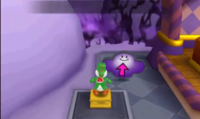
In Mario Party: Island Tour, a springboard briefly appears on the Star-Crossed Skyway board, where the player jumps onto it to launch themselves to the fourth area of the board after the third Star Stage.
Profiles
Super Smash Bros. series
Super Smash Bros. Brawl trophy
Super Smash Bros. for Nintendo 3DS / Super Smash Bros. for Wii U trophy
Blue indicates exclusive to the Wii U version.
Super Mario Maker
- Play Nintendo: "Trampolines are great to help Mario reach higher places, but you can also use them to bounce shells to create some high-flying fun!"[19]
Gallery
Artwork
Background image for New Super Mario Bros. U Deluxe featuring various items
Background image for Super Mario Maker 2
Sprites and models
Donkey Kong Jr. (arcade)
Super Mario Maker (Super Mario Bros. style/costume)
Screenshots
Names in other languages
Trampoline
| Language | Name | Meaning |
|---|---|---|
| Japanese | ジャンプ台[20] Janpudai トランポリン Toranporin |
Jump Stand Trampoline |
| Chinese | 跳台 Tiàotái |
Diving Platform |
| Dutch | Trampoline |
- |
| Italian | Trampolino |
Trampoline |
| Korean | 스프링 Seupeuring 슈퍼점프대 Syupeo Jeompeudae (Mario & Luigi: Partners in Time) |
Spring Super Jump Stand |
| Portuguese | Plataforma de Salto |
Jump Platform |
| Spanish | Trampolín Muelle[21] Plataforma de salto[22] |
Trampoline Spring Jump platform |
Warp trampoline
| Language | Name | Meaning |
|---|---|---|
| Japanese | ワープトランポリン[23] Wāpu Toranporin |
Warp Trampoline |
Smile trampoline
| Language | Name | Meaning |
|---|---|---|
| Japanese | ニコニコトランポリン[23] Nikoniko Toranporin |
Smile Trampoline |
References
- ^ Hiroo Tochikubo, How to Win at Super Mario Bros., Tokuma Shoten, 1987, ISBN 4-19-720003-XC. Page 32.
- ^ Hodgson, David S J, Bryan Stratton, and Stephen Stratton. Super Mario Sunshine Prima's Official Strategy Guide. Page 15.
- ^ Musa, Alexander, and Geson Hatchett. Super Mario 3D World PRIMA Official Game Guide. Page 19.
- ^ Donkey Kong Junior instruction card
- ^ Donkey Kong Jr. NES instruction booklet, page 6.
- ^ Game Boy Donkey Kong English instruction booklet, page 16.
- ^ Super Mario Bros. English instruction booklet, page 14.
- ^ Hiroo Tochikubo, How to Win at Super Mario Bros., Tokuma Shoten, 1987, ISBN 4-19-720003-XC. Page 7.
- ^ M. Arakawa. Super Mario All-Stars Player's Guide. Page 28.
- ^ Super Mario Bros. Nintendo 3DS Virtual Console digital instruction manual, page 10 / 13
- ^ Super Mario Bros. Deluxe instruction booklet, page 19.
- ^ Super Mario World English instruction booklet, page 22.
- ^ Nintendo Power Advance V.4, page 13.
- ^ Super Mario RPG: Legend of the Seven Stars English instruction booklet, page 16.
- ^ Nintendo Power Volume 58, pages 84 and 85.
- ^ Campbell, Stuart. Game Boy Game Secrets, 1999 Edition Prima's Official Strategy Guide. Page 96. "Walk on a sun block to reach another platform with another sun block."
- ^ Template:Ref quote
- ^ Mario vs. Donkey Kong: Tipping Stars digital manual Section 11
- ^ How to Use Shells in Super Mario Maker. Play Nintendo. December 14, 2015, 21:25:38 UTC snapshot via Wayback Machine. Retrieved August 16, 2020.
- ^ Super Mario World Japanese instruction booklet (fold-out)
- ^ Official Mario vs. Donkey Kong website (Guías Nintendo)
- ^ Super Mario World: Super Mario Advance 2 Spanish instruction booklet.
- ^ a b Super Mario RPG Japanese instruction booklet, page 16.
- Tools/Equipment
- Donkey Kong (Game Boy) Items
- Mario & Luigi: Partners in Time Items
- Mario vs. Donkey Kong Objects
- Mario vs. Donkey Kong 2: March of the Minis
- Mario vs. Donkey Kong: Minis March Again!
- Mario vs. Donkey Kong: Mini-Land Mayhem!
- Mario vs. Donkey Kong: Tipping Stars
- New Super Luigi U Objects
- New Super Mario Bros. Objects
- New Super Mario Bros. 2 Objects
- New Super Mario Bros. U Objects
- New Super Mario Bros. Wii Objects
- Paper Mario: Color Splash Objects
- Super Mario 3D World Objects
- Super Mario Advance 4: Super Mario Bros. 3 Objects
- Super Mario Bros. Objects
- Super Mario Bros. Special
- Super Mario Bros.: The Lost Levels Objects
- Super Mario Galaxy Objects
- Super Mario Galaxy 2 Objects
- Super Mario Maker Costumes
- Super Mario Maker Objects
- Super Mario Maker 2 Objects
- Super Mario Run Objects
- Super Mario Sunshine Objects
- Super Mario World Objects
- Super Paper Mario Objects
- Super Smash Bros. Brawl
- Super Smash Bros. Brawl Items
- Super Smash Bros. Brawl Trophies
- Super Smash Bros. for Nintendo 3DS / Wii U
- Super Smash Bros. for Nintendo 3DS / Wii U Items
- Super Smash Bros. for Nintendo 3DS Trophies
- Super Smash Bros. for Wii U Trophies
- Super Smash Bros. Series Objects

